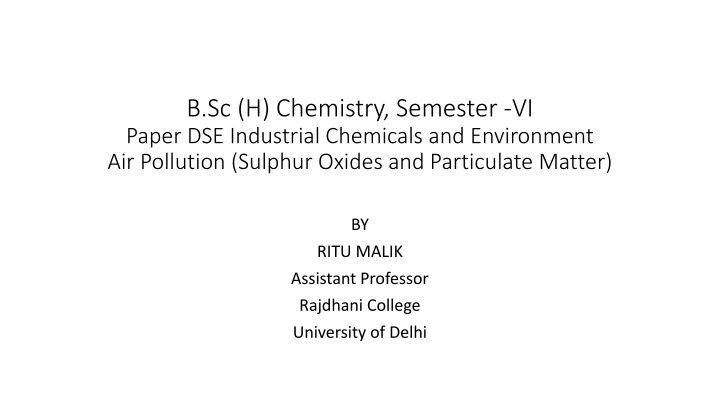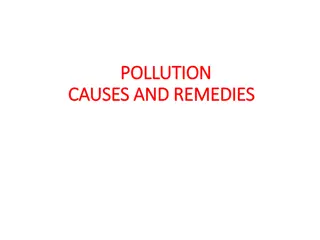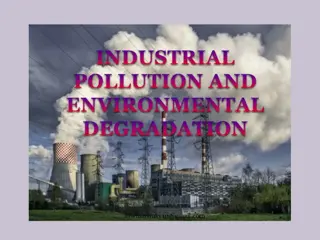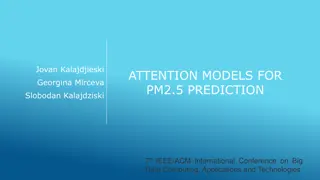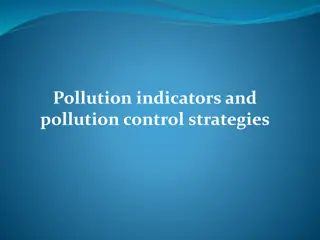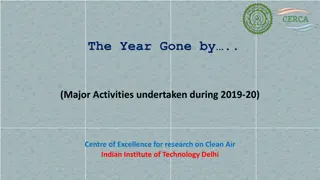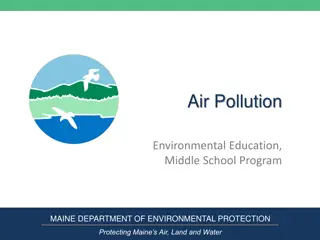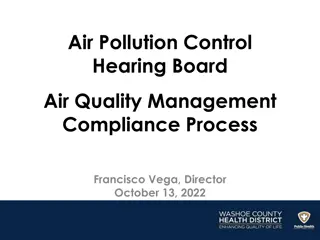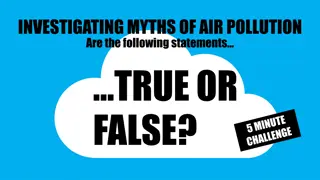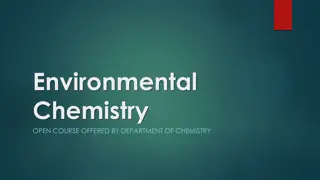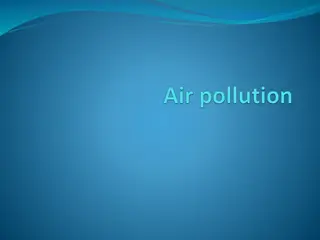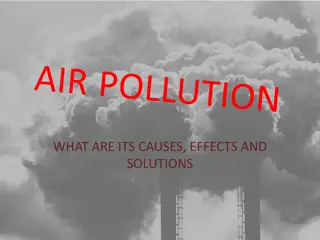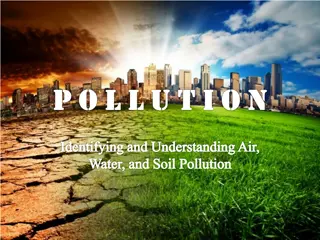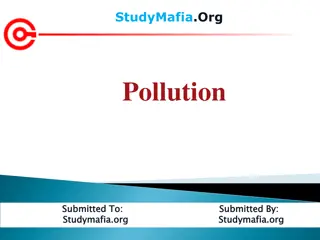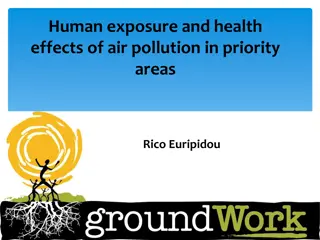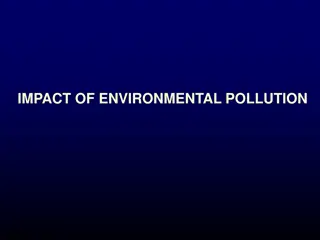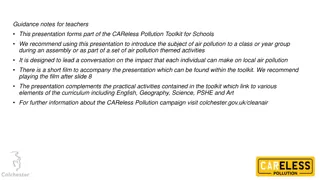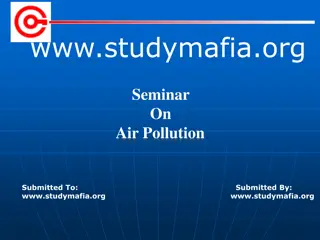Air Pollution and Its Types
Air pollution is the contamination of the environment by various agents, causing harm to humans, animals, and the ecosystem. It is generated through natural and human activities, with factors like meteorology and topography influencing its impact. Primary pollutants are emitted directly, while secondary pollutants form through reactions in the atmosphere. Key pollutants include sulfur dioxide, carbon monoxide, nitrogen oxides, and particulate matter. Sources of pollution include burning fossil fuels, industrial processes, and natural events like volcanic eruptions. Sulphur oxides, a major pollutant, contribute to issues like acid rain and health hazards.
Download Presentation

Please find below an Image/Link to download the presentation.
The content on the website is provided AS IS for your information and personal use only. It may not be sold, licensed, or shared on other websites without obtaining consent from the author.If you encounter any issues during the download, it is possible that the publisher has removed the file from their server.
You are allowed to download the files provided on this website for personal or commercial use, subject to the condition that they are used lawfully. All files are the property of their respective owners.
The content on the website is provided AS IS for your information and personal use only. It may not be sold, licensed, or shared on other websites without obtaining consent from the author.
E N D
Presentation Transcript
B.Sc (H) Chemistry, Semester -VI Paper DSE Industrial Chemicals and Environment Air Pollution (Sulphur Oxides and Particulate Matter) BY RITU MALIK Assistant Professor Rajdhani College University of Delhi
AIR POLLUTION Air Pollution is the contamination of the indoor or outdoor environment by any chemical, physical or biological agent that modifies the natural characteristics of the atmosphere. It may cause diseases, allergies and even death in humans and harm other living organisms such as animals and food crops and damage the natural or built environment. Air pollution is generated due to both natural and human activity. Factors affecting Air Pollution: 1. Meteorology 2. Topography 3.Physical and chemical properties of the pollutants
TYPES OF AIR POLLUTANTS Primary Air Pollutants: These air pollutants are emitted directly from the source into the atmosphere. Examples: Sulfur dioxide, Carbon monoxide, Nitrogen oxides and Particulate Matter. Secondary Air Pollutants: These pollutants are not emitted as such but, when other pollutants (primary pollutants themselves or primary pollutant and atmospheric components) react in the atmosphere. Examples are photochemical oxidants (acids, Nitrogen dioxide, Sulfur dioxide and ozone); and Secondary particulate matter.
Types of Air Pollutants as recognized by EPA Carbon monoxide Sulphur dioxide Nitrogen Oxides Ozone Particulate Matter Lead
Sources of Sulphur Oxides ( ???) 1. 2. 3. Natural Sources: Eruption of Volcanoes (??2) Sea Sprays (Sulphate aerosols) Biogenic decomposition: on land, (?2S) in sea, [Dimethyl sulphate [(??3?)2??2] man made (??2)
Anthropogenic Sources of ??? Burning of fossil fuels (coal, petroleum and petroleum products) Petroleum refinery processes Smelting of sulfide ores ( Copper and Zinc ores) Manufacture of Sulfuric acid Manufacture of paper Burning of domestic refuse
POLLUTION DUE TO SULPHUR DIOXIDE(??2) Sulphur dioxide is a primary pollutant but once released into atmosphere, also creates secondary pollutants such as sulphate aerosols, particulate matter and acid rain. Hydrogen Sulphide is oxidized to Sulphur dioxide by atomic oxygen or molecular oxygen or ozone. ?2? + ? SH + OH SH + OH + ?2 ??2+ ?2O ?2? + 3/2 ?2 ??2+ ?2O ?2? + ?3 ??2+ ?2O
Continued The Sulphur dioxide so formed exists in atmosphere for 2-4 days. It disperses to far-off places and also gets oxidized both photo chemically and non-photo chemcally. Photochemical oxidation ? ??2 ??2 Non- Photochemical oxidation ??????????? ??2 + ?3 ??3+ ?2 ??2+ 1/2?2 Above reaction takes place in the presence of catalysts such as oxides of aluminium, calcium, chromium, iron, lead or vanadium; dust /soot. ??3
Continued ??2+ O + M ??3+ M Where M is the third body able to absorb the energy, usually a molecule of ?2/ ?2 Sulphur trioxide reacts with water to form sulphuric acid ??3+ ?2O ?2??4 Sulphur dioxide when dissolved in fog /cloud droplets, forms sulphurous acid which gets further oxidized to sulphuric acid in the presence of metal salts.
Continued ??2+ ?2O ?2??3 ????? ????? ?2??3+ ?2 ?2??4 Sulphuric acid also reacts with ammonia or sodium salts to form sulphates to form sea sprays.(particulate matter) ?2??4+ 2 ??3 (??4)2??4 ?2??4+ 2NaCl ??2??4+ 2HCl Effects of Sulphur Oxides Pollution Human Health: Inhalation of particulates with adsorbed Sulphur oxides lead to breathlessness, bronchitis and lung cancer.
Effects of Sulphur Oxides Vegetation: Sulphur oxides interfere chlorophyll synthesis and destroy the plant cells. Leaf blotching and low crop yield is observed. Non-living materials 1. Stone leprosy (erosion of carbonate stones) 2. Metal corrosion 3. Retardation of drying of paints 4. Discoloration and embrittlement of paper 5. Discoloration and weathering of leather and fabric. 6. Deterioration of electrical instruments. 7. Reduced visibility due to sulphate aerosols. 8. Acid Rain
Estimation of Sulphur Oxides 1. Spectrophotometric para-rosaniline method: Air sample is passed through a dil. Aqueous solution of sodium tetrachloromercurate (II) ??2[????4], having sulfamic acid which destroys any nitrogen oxides present in air. And Sulphur dioxide is quantitatively converted into sodium dichloro sulfitomercurate (II). ??2[????2(??3)] ??2[????4] + ??2+ ?2O ??2[????2(??3)] + 2HCl When a mixture of p-rosaniline dye, formaldehyde and phosphoric acid is added to above complex ??2[????2(??3)] , p-rosaniline dye gets converted into p-rosaniline methyl sulphonic acid.
Continued. 2. Conductimetry: Sulphur dioxide is put in a solution of hydrogen peroxide which oxidizes it into sulphuric acid. The resulting increase in electrical conductance due to sulphuric acid is measured. 3. Ion Chromatography (IC): Passing Sulphur dioxide through hydrogen peroxide to form sulphate ions, and further analysis of sulphate ions is done by IC. 4. Flame Photometry: The Sulphur gases are burned in hydrogen flame and Sulphur emission line at 394 nm is observed. 5. Mass direct spectrophotometric methods - Non-dispersive IR absorption, Fourier Transform infrared FTIR analysis, UV absorption, molecular resonance fluorescence and second derivative spectrophotometry; are also used for Sulphur dioxide estimation.
Control Procedures of Sulphur Dioxide 1. Fuel Desulfurization Techniques: In these techniques, coal is desulfurized before combustion. Physico-Chemical Method: Sulphur in coal is present in both organic and inorganic form. The inorganic form of Sulphur in coal generally exists as iron pyrites ???2. Coal is grinded and subjected to hydraulic washing. Inorganic sulphur (???2) being heavier settles at bottom and inorganic Sulphur free coal is collected from the surface. Organic Sulphur in coal is removed by bubbling hydrogen gas through fuel in presence of catalyst (Cobalt-Molybednum oxide). Organic Sulphur gets converted to hydrogen sulphide. It is absorbed in diethanolamine and quickly regenerated by simply warming. It is than oxidized to elemental Sulphur.
Continued ?2S + [O] ?2 + ? Microbial Method: The Bacterial strain- IGT-57, removes sulphur from coal without getting it degraded. Bacteria is cultured in a Sulphur limited chemostat ( in which all nutrients except Sulphur are provided), and required Sulphur is taken from coal. Only organic Sulphur is consumed and inorganic Sulphur from coal is not removed. This is the disadvantage of this method. 2. Flue-Gas Desulfurization Techniques: Sulphur is removed from flue gas and Sulphur oxides are not released into the atmosphere.
Flue Flue- -Gas Desulfurization Techniques Gas Desulfurization Techniques PROCESS REACTION ADVANTAGE/DISADVANTAGE ??(??)2+ ??2 ????3+ ?2O Lime Slurry Scrubbing Huge pile of sludge waste ????3+ ??2 ????3+ ??2(g) Lime Slurry Scrubbing Less basic slurry, but not so efficient ??(??)2+ ??2 ????3+ ?2O Magnesium oxide Scrubbing The sorbent can be regenerated. (done off-site) ??2??3+ ??2 NaH??3+ ?2O NaH??3+Heat ??2??3+ ??2+ ?2O Sodium base Scrubbing No major limitations; High annual costs. 2NaOH + ??2 ??2??3+?2O Double Alkali Regeneration of expensive Sodium Alkali ??(??)2+ ??2??3 ????3? + 2????
Continued 3. Catalytic reduction of Sulphur dioxide: A mixture of carbon monoxide and Sulphur dioxide is passed over catalyst. Sulphur dioxide is reduced to elemental Sulphur. ???????? 2??2+ S Formally, Pd, Ag, Co or Ni supported on alumina were used as catalyst. But, drawback of this reaction was that carbon monoxide reacts with elemental sulphur to form toxic carbonyl sulphide. ???????? 2CO + ??2 CO + S COS Therefore, Lanthanum Titanyl (?????3) is used as catalyst to suppress the carbonyl sulphide formation.
Sources of Particulate Matter Natural Sources: Meteorites Volcanic Eruptions Vegetation [ spores, pollens, terpenes ( -pinene discharged from forest trees)]. These cause blue haze in atmosphere due to dispersion of light Storms: Turbulence introduced due to dust storms and sand storms suspend the particulates in the atmosphere for a longer period of time.
Continued. Forest Fires: Forest fires release polynuclear aromatic hydrocarbons and salts of calcium, iron, zinc and magnesium and these suspend in the atmosphere. Sea Salt Sprays: Salt laden water droplets are introduced into atmosphere by the ocean waves. When water evaporates, salts are left as suspended particles. Anthropogenic Sources: Vehicular Exhaust: The vehicular exhaust (soot, lead compounds, crankcase oil and hydrocarbons) interact with other air pollutants to produce secondary particulates which produce photochemical smog.
Continued. Combustion: ???and ??2produced due to combustion are converted into sulphates and nitrate aerosols. Incomplete combustion of fossil fuels produce soot particles. And; combustion in industries produce fly ash (mixture of silicon, aluminium, calcium and phosphorous). Metallurgical operations: Metallic dust and metal oxides particulates are released due to metallurgy, which provide catalytical surface for unwanted atmospheric reactions.
Particulate Matter and its types Particulate matter also known as particle pollution or PM is a complex mixture of extremely small particle and liquid droplets. It is made up of number of components including acids (such as nitrates and sulphates), organic chemicals metals and soil or dust particles. Particulate Types On the basis of size and origin, particular matter is classified into 2 types: 1. Primary particulates are directly injected into the atmosphere by physical or chemical methods. They are generally 1 to 20 micrometer in diameter (maybe as large as 100 micrometer). Examples from natural sources: pollen, volcanic debries, soil dust and sea salt spray; from Anthropogenic sources: coal, fly ash, cement dust and milled flour. 2. Secondary particulates are formed either due to gas phase reactions or due to reactions between pollutant gases and primary particulates. Examples from natural sources include volcanoes, decaying organic matter and vapours from trees; and from anthropogenic sources include vehicular emissions, industrial operations and combustion processes. Secondary particulates are of three types based on the types of functional groups present: Sulphate particulates Hydrocarbon particulates Nitrate particulates
Continued Sulphate particulates includes sulphuric acid droplets (formed by oxidation of atmospheric sulphur dioxide), metal sulphates (Formed by reaction between sulphuric acid and metal oxide) and ammonium sulphate(Formed by reaction between sulphuric acid and atmospheric ammonia). Conversion of sulphur dioxide into sulphuric acid droplets 1) Oxidation by oxygen atoms ??2+ O + M ??3+ M (3) ??2+ ?2? ?2??4 The Reactive oxygen required in equation (3), is supplied by photo dissociation of nitrogen dioxide. ??2+ hv NO + O
Continued 2. Direct photochemical oxidation: Sulphur dioxide absorbs in the wavelength range 240-320 nm and flips from its ground state(singlet to excited state (triplet) and reacts with molecular oxygen and sulphur dioxide to form sulphur trioxide finally. ??2+ hv ??2 ??2 ??4 ??4 Sulphur trioxide is subsequently transformed into sulphuric acid derivatives. + ?2+ M ??4 + ??2 2??3 + ?2 ??3+ ?3 + M
Continued . 3. Catalytic oxidation of sulphur dioxide to sulphuric acid (via Sulphurous acid) by atmospheric oxygen. The catalyst usually used are metal oxides such as ferric oxide. Thus, sulphuric acid aerosols are formed. ??2+ ?2? ?2??3 2?2??3+ ?2 ?2??4 4. Free Radical Mechanism: Sulphur dioxide is converted to sulphuric acid aerosols by hydroxyl radicals. ??2+ 2?? + M ?2??4+ M
Continued Hydrocarbon particulates Oxidation of olefins: The olefins ( such as terpenes) are oxidised by ozone to give proxy radicals and by atmospheric oxygen to produce aldehydes, ketones and epoxides particulates. ?3+ Olefin ??2 + O Nitrate particulates Nitric acid formed in different reactions is responsible for nitrate particulates 4??2+ ?2+ 2?2O 4???3 ??2+ ??.+ M ???3+ M ??3+ ???3 ??4??3 PbO + 2???3 Pb(??3)2+ ?2O NaCl + ???3 ????3+ HCl
Particulate categorization according to EPA The size of Particulate matter is directly related to their probability to cause health problems. EPA studies about the particles that are 10 micrometers in diameter or smaller as these particles usually pass through air passage. Once inhaled, these particles damage the heart and lungs and cause ill-effects on health. EPA categorized particulates into two categories : "Inhalable coarse particles," found near roadways and dusty industries, are larger than 2.5 micrometers and smaller than 10 micrometers in diameter. "Fine particles," found in smoke and haze, are 2.5 micrometers in diameter and smaller. These particles can be directly emitted from sources such as forest fires, or they can form when gases emitted from power plants, industries and automobiles react in the air.
Control of particulates Many systems are employed to control the particulate matter. These include Gravitational settling chamber, inertial collectors (cyclonic separators), fabric filter collectors (bag houses), wet scrubbers and electrostatic precipitators. Gravitational settling chamber: It is employed to separate particles >50 micrometer. The polluted gas enters the chamber at < 0.3 m/s and particles are allowed to settle due to gravity high density and are separated. Cyclone separator: The polluted gas enters the cyclone separator tangentially from the top and rotates, generating the centrifugal force that throw the particles to the cyclone walls as the gas spirals upwards inside the cone. The particulates slide down the walls of the cone and collected at bottom outlet.
Continued Fabric Filter: It separates particulates 0.5 micrometer. The pollutant gas is passed through a fabric bag that filters out the particulates and allow the clean gas to move out. The particular dust Mat is collected inside the bag and must be cleaned from time to time. Wet collectors: It separates the particulates from polluted gas stream as liquid droplets. Common wet scrubbers are spray tower, venturi scrubber and cyclone scrubber.
Continued Electrostatic precipitator: The carbon other dust particles released in the atmosphere from industries are removed by electrostatic precipitator. In this method, two electrodes are fitted against the inside walls of the smokestack. When high voltage is applied and electric discharge takes place across the stack and as a result air in the stack is ionised. The ionizes air consists of ions and free electrons. The free electrons attached to the gaseous particles moving up the stack. The particles get negatively charged and are attracted to the positive electrode, located on the inner wall of the stack and settle down there. These can be dislodged from the electrodes by vibration of the electrodes and are collected in a reservoir. In this way, about 99% of the particulate matter gets removed from the fuel gases by this process.
REFRENCES Stanley E. Manahan: Environmental Chemistry S.M Khopkar, Environmental Pollution Analysis J.A. Kent: Handbook of Industrial Chemistry G.S Sodhi: Environmental Chemistry
THANK YOU Ritu Malik Assistant Professor Rajdhani College University of Delhi
